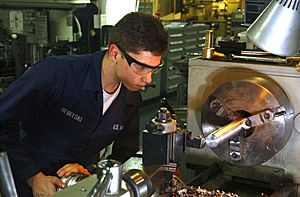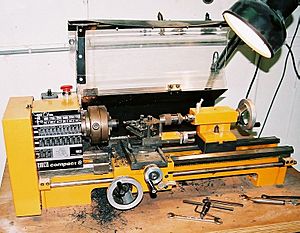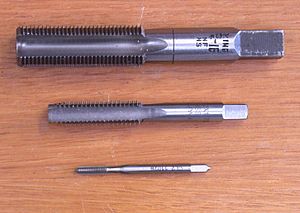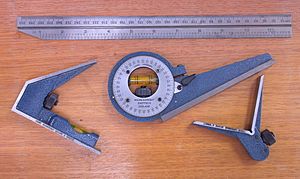Metalworking facts for kids
Metalworking is all about shaping metals to make useful things. This could be small parts, bigger machines, or even huge buildings! People have been working with metal for almost 7,000 years. There are many ways to do it, like machining (cutting), forging (hammering), casting (melting and pouring), and fabricating (putting pieces together).
Contents
How Metal is Shaped
Shaping Metal by Removing Material
This section is about how metal is shaped by taking away parts of it. Imagine carving wood, but with metal!
Milling
Milling is a way to shape metal by carefully removing extra material. This is usually done with a special machine called a milling machine. This machine has a spinning tool, like a drill, that cuts the metal.
The metal piece sits on a table that can move in different directions (up, down, and side-to-side). This lets the spinning tool cut out complex shapes. Milling machines can be controlled by hand or by a computer (called CNC). They can do many jobs, like cutting slots, drilling holes, and making flat surfaces.
Turning
A lathe is a machine that spins a piece of metal very fast. While it spins, special cutting tools are used to shape it. This creates objects that are perfectly round, like candlestick holders, baseball bats, or bowls.
The metal piece is held tightly in the lathe. A strong cutting tool then moves against the spinning metal, shaving off tiny bits. The main difference between a milling machine and a lathe is that in milling, the tool spins and moves, but in a lathe, the metal piece spins and the tool moves.
Modern lathes can even do extra jobs like milling. This means the metal piece stops spinning, and a special tool with its own motor cuts into it. This helps make many different shapes all on one machine.
Cutting
There are many ways to cut metal. You can use a saw, a chisel, or big shears. For faster cutting, people use powerful beams like lasers, hot gas jets, or plasma. Some methods use water or electricity to erode the metal.
Sometimes, a special liquid called cutting fluid is sprayed on the tool and metal. This helps keep them cool and makes the cutting smoother.
Drilling and Threading
Drilling is when you use a drill bit to make holes in metal. As the drill spins, it creates small metal shavings called swarf. These shavings are pushed out of the hole by the drill's design.
Sometimes, a special liquid is used to help the drill work better. This liquid cools the drill and helps the shavings come out easily.
Taps and dies are tools used to make screw threads. A tap cuts a thread on the inside of a hole, so a screw can fit into it. A die cuts a thread on the outside of a rod, turning it into a screw.
Grinding
Grinding uses a rough, abrasive process to remove material from metal. A grinding machine uses a special spinning wheel, called a grinding wheel, to make surfaces very smooth or to create very precise shapes. This wheel can be made from different materials, including diamonds.
The simplest grinders are small machines you might see on a workbench. They are used to smooth rough edges or cut metal quickly.
Grinders today are very advanced. They can be controlled by computers and work very quickly and precisely. They are used to make parts for things like jet engines and other high-tech equipment.
Shaping Metal Without Removing Material
These methods change the shape of metal without cutting or taking any material away.
Casting
Casting is when you melt metal and pour it into a mold. When the metal cools, it takes the shape of the mold.
- Sand casting
- Shell casting
- Investment casting (also called Lost wax casting in art)
- Die casting
- Spin casting
Plastic Deforming
This is about bending, stretching, or squishing metal into new shapes.
- Forging: Hammering metal, often when it's hot, to shape it.
- Rolling: Passing metal through rollers to make it thinner or change its shape.
- Extrusion: Pushing metal through a shaped opening to create a long piece with a specific profile.
- Spinning: Spinning a flat piece of metal and shaping it over a form.
- Stamping: Using a press to cut or shape metal sheets.
Powder Forming
- Sintering: Taking metal powders and pressing them together, then heating them to make a solid part.
Sheet Metal Forming
This is about shaping thin sheets of metal.
- Bending: Folding a metal sheet into a new angle or shape.
- Drawing: Pulling a metal sheet into a cup-like shape.
- Pressing
- Spinning
- Flow turning
- Roll forming
- Wheeling using an English wheel / Wheeling machine
Joining Processes
This section explains how different pieces of metal can be put together.
Welding
Welding is a way to join metal pieces by melting them together. Often, a filler material is added to the melted metal, which then cools and forms a very strong joint. Sometimes, pressure is used with or without heat to make the weld.
Many different power sources can be used for welding, like a hot flame, an electric arc, or even a laser. Welding can be done in many places, including outside, underwater, or even in space!
Welding can be dangerous, so people who weld must be careful to avoid burns, electric shock, breathing in bad fumes, or too much ultraviolet light.
Brazing
Brazing is a way to join metal pieces using a filler metal that melts at a high temperature (above 800°F). The filler metal flows into tiny gaps between the pieces and creates a strong bond when it cools.
Unlike welding, the main metal pieces do not melt during brazing. This means there is less stress on the metal, and the joined parts can be more flexible.
Soldering
Soldering is similar to brazing, but it happens at lower temperatures (below 800°F). A filler metal melts and flows into gaps to join pieces. However, the connection between the filler and the main metal is not as strong as in brazing, so the joint is weaker.
Hand Fabrication
Skilled workers can use many different hand tools to shape and join metal. Even without big machines, an experienced person can make almost any metal part using just their hands and simple tools. This might take more time, but it shows how much can be done with traditional skills.
Tools used include those for cutting, scraping, hammering, marking, and holding metal pieces.
Images for kids
-
Le Marteleur by Constantin Meunier (1886)
See also
 In Spanish: Metalistería para niños
In Spanish: Metalistería para niños
















